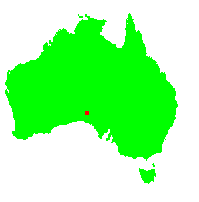General Description:
Grevillea treueriana is a small shrub of open habit to 1-1.5 metres high by a similar width. Leaves are 25-30 mm long with recurved margins. They are deeply divided into stiff, linear lobes with sharp, pungent points. The “toothbrush”-shaped flower clusters are bright orange red and tend to hang downwards from the ends of the branches. Flowering occurs in winter though to spring.
This species has not been widely cultivated but is now becoming more readily available through specialist native plant nurseries. It is best suited to areas with a dry summer climate and it may prove more difficult in humid, wet summer districts such as coastal New South Wales and Queensland. In those areas grafting onto a hardy rootstock may be necessary for long term growth. It should be grown in a warm, sunny location in well drained soils. It is tolerent of at least moderate frosts. Like most grevilleas, the flowers attract honey-eating birds.
The species can be grown from seed which should be “nicked” with a sharp knife prior to sowing to improve germination. Cuttings from firm, current season’s growth can be slow to strike and success is improved by using a root promoting hormone. The species has been successfully grafted to hardy root stocks such as G.robusta and G.”Poorinda Royal Mantle”.
* EPBC Act = Environment Protection and Biodiversity Conservation Act 1999;
ROTAP = Rare or Threatened Australian Plants (Briggs and Leigh, 1988)
For further information refer the Australian Plants at Risk page

Grevillea treueriana
Photo: Brian Walters
 Australian Native Plants Society (Australia)
Australian Native Plants Society (Australia)